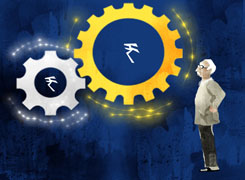Ramalingam Kalirajan |10270 Answers |Ask -Follow
Mutual Funds, Financial Planning Expert - Answered on Jul 30, 2025
He has an MBA in finance from the University of Madras and is a certified financial planner.
He is the director and chief financial planner at Holistic Investment, a Chennai-based firm that offers financial planning and wealth management advice.... more

Sir my son has been admitted to the B Tech course in Jecrc university jaipur through Kalvium Company. I want to take a study loan for him from the 3rd year onwards. How will it, be possible for him?
Let’s explore this from all angles—cost, eligibility, repayment, and impact—step by step.
? Loan eligibility for the student
– Your son must be an Indian citizen.
– He should be enrolled in a recognised Indian university. JECRC is recognised.
– He must have cleared the previous semesters.
– Co-borrower is mandatory. Usually, the parent or guardian becomes the co-borrower.
– CIBIL score of co-borrower matters. A score above 700 improves loan chances.
? Loan coverage and expenses included
– Most banks and NBFCs cover tuition, hostel, exam, library, and lab fees.
– Travel expenses, laptop cost, and study material can also be included.
– Some also allow a fixed monthly living expense to be included.
? Loan amount generally approved
– Rs 4 to 7.5 lakhs: Usually sanctioned without collateral.
– Rs 7.5 lakhs and above: Needs collateral security.
– Government banks usually offer up to Rs 10 lakhs for domestic education.
– NBFCs offer higher, but charge more interest.
? Documents usually required
– Admission letter from JECRC University.
– Kalvium tie-up acceptance or enrolment confirmation.
– Course fee structure on university letterhead.
– Academic records of the student (10th, 12th, current semester).
– KYC of student and co-borrower.
– Income proof of co-borrower (salary slip or ITR).
– Bank statements of last 6 months.
– PAN and Aadhaar for both.
? Which banks you may explore
– PSU Banks like SBI, Union Bank, Canara Bank.
– Private banks like Axis, ICICI, IDFC First.
– NBFCs like Avanse, InCred, Auxilo, HDFC Credila.
– Some offer pre-admission approval too.
– Government-backed Vidya Lakshmi portal also lists education loans.
? Role of Kalvium in loan support
– Kalvium-backed programs are skill-based, with internships.
– Banks will review the internship offer and earning potential.
– This may help boost the employability profile and repayment capacity.
? From 3rd year – special consideration
– Taking a loan mid-course is allowed.
– Banks may ask for academic records of 1st and 2nd year.
– Consistent academic performance builds trust for approval.
– Bank may disburse loan directly to the college account.
? Interest rate range and type
– For government banks: Around 8.5% to 10.5%.
– For NBFCs: Can go up to 13%-15%.
– Some banks offer interest subsidy (explained below).
– Simple interest may apply during study period.
– After moratorium, full EMI starts with compound interest.
? Interest subsidy by Government
– Central Sector Interest Subsidy (CSIS) is available.
– Applies to families with income less than Rs 4.5 lakhs yearly.
– Covers interest during moratorium (study period + 1 year).
– You must apply through a government-recognised bank.
– Co-borrower’s income proof is mandatory.
? Moratorium period and EMI start
– Moratorium = course duration + 1 year.
– EMI starts after this period ends.
– You can choose to pay only interest during study years.
– Or you can opt for full EMI if financially comfortable.
– Early interest payments reduce overall burden.
? Tax benefit under Section 80E
– Interest paid on education loan is tax deductible.
– There is no cap on deduction amount.
– Benefit can be claimed for 8 years.
– Only the interest part of EMI qualifies.
– Co-borrower (parent) can claim if loan is in their name.
? Impact on your credit profile
– Loan gets reflected in both student and co-borrower’s credit report.
– Timely EMI ensures good credit record for your son.
– This builds financial discipline and future loan eligibility.
– Any missed EMI will affect your CIBIL score.
? Loan process and disbursement timeline
– First step: Apply online or at bank branch.
– Approval may take 7–15 working days.
– Banks may verify documents, co-borrower’s profile, and course details.
– Loan is disbursed semester-wise or yearly, not lump sum.
– Funds go directly to the college account, not student.
? Things to avoid while selecting lender
– Don’t choose lender just for quick approval.
– Check prepayment charges. Many banks don’t charge, NBFCs do.
– Compare processing fees (ranges Rs 5,000 to Rs 15,000).
– Fixed interest loans can become costly in long run.
– Choose floating rates if possible, with option to refinance.
? Loan repayment post studies – a snapshot
– Total tenure is usually 7–10 years after moratorium.
– Option to extend tenure reduces EMI but increases interest.
– Foreclosure allowed after 6–12 months in most cases.
– If placed early, start repayment early to save interest.
– Some banks allow part payments without penalty.
? In case of job loss or delay in placement
– Banks usually grant grace period of 3–6 months.
– But written request must be submitted with justification.
– This is at bank’s discretion, not mandatory.
– Always stay in touch with bank during hardship.
? Collateral requirement – when and how
– Loans up to Rs 7.5 lakhs are unsecured.
– Above that, banks ask for residential property, LIC policy, or FD as collateral.
– Property should have clear title and be in India.
– Co-borrower must be legal owner or co-owner.
? Alternatives if loan is rejected
– Explore NBFCs that are education loan specialists.
– Consider gold loan as last resort, if amount is low.
– Loan against FD can be cheaper if funds are available.
– Educational scholarships may ease burden. Explore Kalvium or JECRC support.
? Should you delay and save instead of loan?
– From 3rd year, time is short for meaningful saving.
– Education is a productive loan.
– Don’t compromise child’s future for short-term liquidity.
– Use your earnings to support early part.
– Let loan fund the remaining.
? Final documentation check-list reminder
– Student KYC and 10th/12th mark sheets.
– College admission proof and fee breakup.
– Co-borrower’s KYC, income, PAN, Aadhaar.
– Previous academic semester reports.
– Bank passbook or salary slips.
– Property documents, if collateral required.
? Final Insights
– Education loan is a practical way to invest in your son’s career.
– From 3rd year, approval depends on consistent performance and clear documentation.
– Compare banks and NBFCs patiently.
– Prioritise lower interest, transparent terms, and service support.
– Avoid over-borrowing.
– Make your son part of the repayment journey.
– This builds responsibility and discipline.
Best Regards,
K. Ramalingam, MBA, CFP,
Chief Financial Planner,
www.holisticinvestment.in
https://www.youtube.com/@HolisticInvestment
You may like to see similar questions and answers below
Sushil Sukhwani |617 Answers |Ask -Follow
Study Abroad Expert - Answered on Jan 02, 2024
Ramalingam Kalirajan |10270 Answers |Ask -Follow
Mutual Funds, Financial Planning Expert - Answered on Jul 17, 2024
Samkit Maniar | Answer |Ask -Follow
Tax Expert - Answered on Jul 25, 2024
Samraat Jadhav |2423 Answers |Ask -Follow
Stock Market Expert - Answered on Aug 18, 2025
Samraat Jadhav |2423 Answers |Ask -Follow
Stock Market Expert - Answered on Aug 18, 2025
Samraat Jadhav |2423 Answers |Ask -Follow
Stock Market Expert - Answered on Aug 18, 2025
Radheshyam Zanwar |6413 Answers |Ask -Follow
MHT-CET, IIT-JEE, NEET-UG Expert - Answered on Aug 18, 2025
Radheshyam Zanwar |6413 Answers |Ask -Follow
MHT-CET, IIT-JEE, NEET-UG Expert - Answered on Aug 18, 2025
Radheshyam Zanwar |6413 Answers |Ask -Follow
MHT-CET, IIT-JEE, NEET-UG Expert - Answered on Aug 18, 2025
Radheshyam Zanwar |6413 Answers |Ask -Follow
MHT-CET, IIT-JEE, NEET-UG Expert - Answered on Aug 18, 2025
Radheshyam Zanwar |6413 Answers |Ask -Follow
MHT-CET, IIT-JEE, NEET-UG Expert - Answered on Aug 18, 2025
Radheshyam Zanwar |6413 Answers |Ask -Follow
MHT-CET, IIT-JEE, NEET-UG Expert - Answered on Aug 18, 2025
Radheshyam Zanwar |6413 Answers |Ask -Follow
MHT-CET, IIT-JEE, NEET-UG Expert - Answered on Aug 18, 2025





















